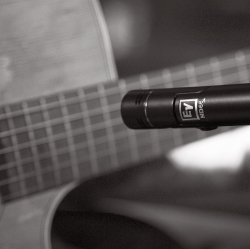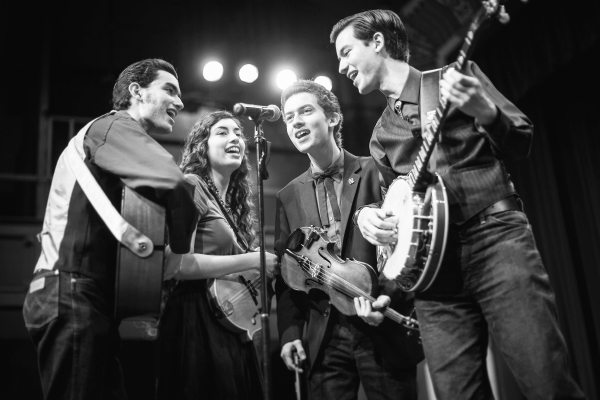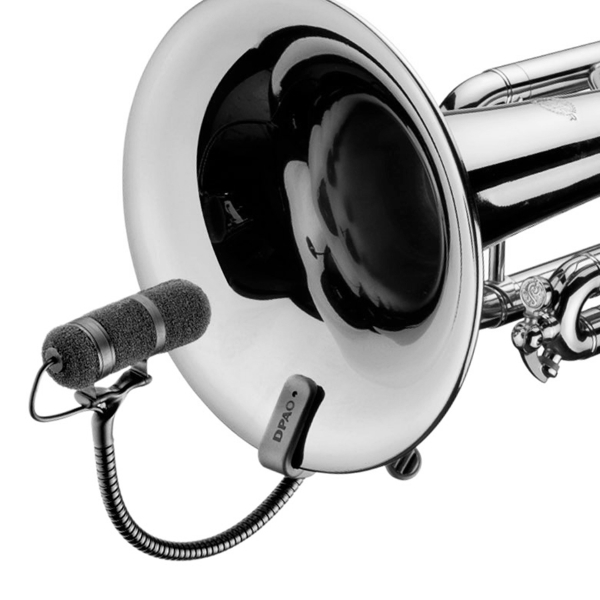
Upright Bass
Everything from a dynamic like a Shure SM58 wrapped in forum stuffed under the bridge to small clip-ons can produce good results with an upright bass.
For players that don’t move around, I prefer to stand-mount a large dynamic like an AKG D112 or Shure BETA 52 pointed at one of the “F” holes. Earlier this year in a Road Test of Lewitt Audio’s Beat Kit Pro 7 drum kit, I put an DTP 640 dual-element mic on an upright. The two elements (large-diaphragm dynamic and small-diaphragm condenser) provided an excellent, very rich tone.
Bluegrass Band.
Many of the individual techniques noted here can be used with bluegrass (and other acoustic) groups, of course, but the single mic technique is also quite effective.
In the “old days” many musical groups would opt for a single mic to capture live performances (and recordings). The mic is placed center stage, with the musicians spaced around it. Musicians get closer or farther away from the mic as needed for leads and solos.
This technique is popular again and a single mic onstage allows for good gain before feedback as there are no other open mics onstage.
A large-diaphragm cardioid condenser like the Baby Bottle from Blue does a quality job, with a traditional look, for small bluegrass and acoustic ensembles.
I’ve used a single mic for up to four performers, and if it’s larger than that, split the group around two matched mics. Note that there still might be need to mic an upright bass with this technique in order to capture it clearly.

Brass
Trumpets, cornets, trombones, tubas and the like can get quite loud, so it’s best to utilize mics designed for high SPL.
For higher pitched instruments (i.e., trumpets) place a dynamic like a beyerdynamic M88 a few inches in front of the bell, and ask the performer not to inset the mic into the horn.
Another solution is clipping a small condenser such as a DPA 4099 to the bell. For larger instruments (i.e., tuba), do the same or try placing the mic inside the bell. A sousaphone performer I recently worked with likes to drop an SM58 inside his instrument and walk around the stage. It actually sounded quite good.
French horns are also brass, but because they’re usually played in orchestras or chamber ensembles with the performers hand inside the bell, they require different treatment. An RE20 or RE320 about 8 to 12 inches away, pointed at the bell, captures the unique sound of this instrument.
Woodwinds
Reed instruments are a bit different that horns in that the sound can emanate from the open keys in addition to the bell. Because of this, try placing a single mic directly in front of a clarinet or oboe to pick up the whole instrument. A larger diaphragm Sennheiser MD421 is my top choice here.
Saxophone
Also a woodwind instrument, but many sax players are used to a single mic at the bell. If a player prefers wireless, we stock some Shure SM98 and BETA 98 clip-ons that work with our systems. An Audio-Technica ATM350, DPA 4099 and AKG C519 also work great. When the performer is stationary, an MD421 is another option. A few years ago I worked with a group called Saxophobia that featured the “world’s largest” saxophone, with an SM58 on a gooseneck stand picking up the low notes from that sizeable instrument very well.
Flute
A common approach is placing a mic in front of the player’s mouthpiece. The resulting wind noise into the mic can make every note sound like Jethro Tull. My method now is placing a Countryman E6 earworn directional mic on the musician so the breath is moving away, so all that’s picked up is the instrument. This technique also works well with piccolos and pan pipes.

